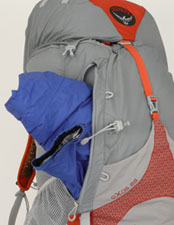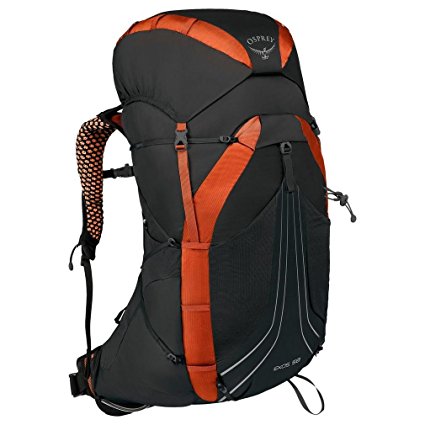- Lightweight pack with AirSpeed suspension system for fast, active pursuits
- Aluminum frame, 3D mesh back panel, and side crescent ventilation
- Sewn-in hydration sleeve with hydration tube routing points
- Removable floating top pocket and 2 vertical zippered pockets
- Measures 13 x 28 x 12 inches (W x H x D); comes in small, medium, and large
Product Description
Super Light weight backpacking pack features a superlight 7mm webbing side compression, stow-on-the-go Trekking Pole Attachment, front stretch woven pocket, reflective detail to front pocket, cord tie-off points, under-lid pocket, zippered mesh hipbelt pockets, sleeping pad straps, and side stretch woven pockets with inner or outer compression
Amazon.com
Need a good lightweight pack for fast and active outdoor pursuits? Turn to the Exos 58, a highly specialized pack built for everything from daylong hikes to multi-week adventures. The Exos 58 is equipped with Osprey’s AirSpeed suspension system, which combines an aluminum frame with a 3D tensioned mesh back panel and side crescent ventilation. This ventilated design is built for comfort, with all contact surfaces made of either breathable mesh or perforated, molded waffle foam. As a result, the pack fits your body perfectly, with no hot spots to distract you whether you’re bagging a fourteener, hiking the Appalachian Trail, or pulling your next 24-hour race. As with any high-quality pack, the Exos 58 also includes an internal sewn-in sleeve that accommodates up to 3 liters of hydration, with H20 icons on the top of the pack marking the routing points for your hydration tube. And, of course, the top-loading Exos 58 offers several storage pouches for your gear, including a large main compartment, a removable floating top pocket with an under-lid mesh pocket, two vertical zippered front pockets for easy-access items, and a stretch-woven front pocket with an integrated over-skirt compression strap.
The pack also includes a couple of dual mesh side pockets with InsideOut compression, allowing you to tension and secure your load easily when the pockets are in use. And serious trekkers will love the Stow-on-the-Go trekking pole attachment, which leaves both your hands free for climbing. Other details include a mesh-covered foam BioStretch harness with an adjustable sternum strap; a BioStretch hip belt with an ErgoPull closure; a single tool loop and bungee tool tie-off for ice axes and other useful accessories; and integrated straps for holding sleeping pads. The pack comes in small, medium, and large sizes.
 
The Exos 58 includes a hydration sleeve with exit ports and a pair of zippered front pockets. |
Specifications
- Dimensions: 13 x 28 x 12 inches (W x H x D)
- Small: 3,300 cubic inches; 2 pounds 7 ounces
- Medium: 3,500 cubic inches; 2 pounds 8 ounces
- Large: 3,700 cubic inches; 2 pounds 10 ounces
About Osprey
Things at Osprey move full circle, starting with the people, then the product, and then back to the people for the full lifetime of the product. Headquartered in Cortez, Colorado, in the southwest part of the state, the company is nestled at the corner of the rugged San Juan Mountains and on the edge of vast sandstone canyon country. This landscape provides the Osprey staff with constant inspiration and a superb testing ground for the company’s packs. The remainder of the company–including Osprey founder and head designer Mike Pfotenhauer–resides in Ho Chi Minh City, Vietnam. In HCM City, surrounded by heat, endless bustle, and vibrant energy, Osprey designs and builds its packs to exacting standards. Living in HCM City provides many benefits, including the ability to create face-to-face relationships with the factories that build its packs, ensure fair labor standards, and soak up the design inspiration of a cosmopolitan city.
Amazon.com Backpack Guide
Finding the Right Backpack
For extended trips into the backcountry, there’s no getting around the fact that you’ll have to carry life-sustaining supplies on your back. Here are some things to keep in mind when shopping for a backpack:
Internal vs. External
Up until late 1970’s, external frame packs–which consist of an exposed, lightweight metal frame attached to a fabric pack-bag–were the only thing going. In recent years, though, packs that place the support structure of the pack inside the pack, known as internal frame packs, have boomed in popularity.
The good news about internal frame packs is that they hold the weight of your load close to your body, making it easier to maintain your balance on uneven terrain. Meanwhile, internals provide stiffness and support, but they are not completely rigid, which makes them more flexible when you’re doing active sports. With the added flexibility comes a high degree of compressibility, meaning you can use the pack’s compression straps to cinch down your load and keep items from shifting and throwing you off balance. Internals also sport slimmer shapes that allow for more arm movement in all directions–another big plus for off-trail bushwhackers, skiers and climbers. Last but not least, internal frame packs offer a greater range of adjustability in the shoulder harness and hip-belt than external frame packs.
There are some negatives for internals. First, once packed, it can be difficult to grab needed items out of them quickly. And because internal frame packs consolidate the load into a single, body-hugging unit, proper packing is very important. To distribute the weight properly, you should pack your heaviest items close to your back and in the middle portion of the pack-bag. Plan on getting a sweaty back with an internal, too, given the fact that they are pressed right against you. Finally, internal frame packs are priced higher than external models.
External frame packs are very good at focusing the weight of a load directly to the right place: your load-loving hips. While internals, when properly packed, do this effectively, too, you can always rest assured that an external will distribute the load evenly, no matter how unevenly packed it may be. Externals also offer easy access to your gear via multiple, easily-accessible compartments. Plus, because externals don’t situate the load directly against your back, you’ll enjoy far more air flow. Finally, if you’re on a budget, or you’re buying for a growing child, externals are more affordable.
If you plan on hiking on easy to moderate trails and you don’t need a lot of body movement, you’ll probably be fine with an external. But because externals are so rigid and inflexible, challenging trails or any kind of off-trail pursuit can become painful and frustrating. Also know that your balance is far more compromised with an external frame pack during activities like stream crossings and hops through talus fields.
Packs for Shorter Trips
In addition to backpacks designed for overnight trips, rucksacks are great for day-trips, warm-weather one-nighters, single-day ski trips, or fast alpine assaults. Some rucksacks blur the line between backpack and rucksack with integrated internal supports and sophisticated hip belts and shoulder harnesses. Choose a pack in this category based on your intended use. Short day hikers don’t need an internal frame, while climbers and skiers with heavier loads likely do.
Sizes and Capacities
Packs in the 3,000 cubic inches and lower category are good for day hikes or overnighters in warm weather with minimal gear. Packs in the 3,000 to 4,000 cubic inch range are good for one- or two-night trips in colder weather. If you’re going to be out for up to three days, look for a pack in the sub-4,000 cubic inch range. Choose a pack with 5,000-6,000 cubic inches for week-long outings. And finally, for trips lasting a week or more, you’ll need something in the 6,000-plus cubic inch category. Keep in mind, though, that bigger packs weigh more, and since every ounce counts, you’ll want to choose a pack that offers just enough space for your outings and no more.

